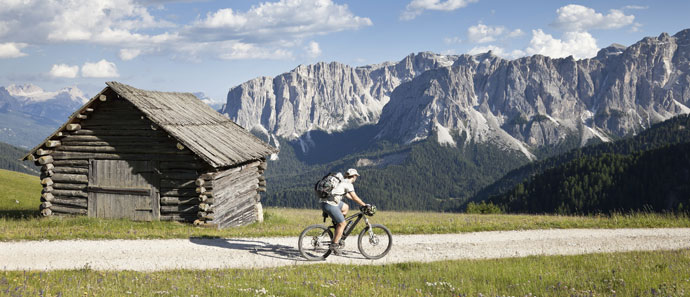The average bicycle trip in Britain is now 3.2 miles – an ideal distance for getting to work or the shops, but one that pales in comparison with the pedal-powered adventures that bikes make possible.
There was a time, not so long ago, when long rides and cycle touring holidays were common. It begs the question, how far would you cycle?
At the extreme are those who cross continents by bike; hardy souls whose fitness must be matched by resourcefulness and an appetite for adventure. The following three examples span a more than a century of adventure cycling.
Adventure cycling in 2014
Cambridge University student Peter Dudfield recently completed a 30,000km bike ride around the world. The journey took 380 days as he hauled 30kg of luggage across five continents – an endeavour that is exceptional but by no means unprecendented. Bicycles are the ideal way to explore the world around us. Strong enough to carry luggage, quiet enough as as not to disturb the local environment and slow enough to allow for genuine interaction with people and places, for as long as there have been bicycles, cyclists have used them for adventure.
…1940
Seventy-four years ago, and towing his sleeping quarters behind him in a home-built trailer, an eighteen-year-old cyclist from Michigan recently travelled nearly 1,200 miles. The October 1940 edition of Modern Mechanix reported that the intrepid teenager had postcards that he sold to curious spectators to pay for his supplies during the two-week journey.
…1900
The pioneer adventure cyclists of the 1890s took to the snowy wilds of northern Canada without the benefit of modern clothing and many decades before the advent of mountain bikes.
The Last Great Gold Rush in the late nineteenth century drew 100,000 prospectors to the Klondike region of the Yukon in north-western Canada between 1896 and 1899.
It was not an endeavour for the faint hearted; more than half of those who made the journey died and only around 4,000 struck gold. The gold rushers usually bought buy teams and supplies to traverse the frozen wilderness of Yukon and Alaska, but those who didn’t have the money to invest in dog teams used bicycles.

Hardy soul: The cover of Terrence Cole’s account of Alaskan cycling at the turn of the twentieth century, Wheels on Ice.
By following in the dogsled tracks the intrepid ‘wheelmen’ cyclists were able to make good time. The bicycles might have been cheaper to buy and maintain than the a team of dogs, but they suffered from frozen bearings and tyres.
19-year-old Max Hirschberg chose to use a bicycle when he joined the gold rush in 1900. His journal gives a fascinating insight into the cold weather gear of the day:
“The day I left Dawson, March 2, 1900, was clear and crisp, 30° below zero. I was dressed in a flannel shirt, heavy fleece-lined overalls, a heavy mackinaw coat, a drill parka, two pairs of heavy woollen socks and felt high-top shoes, a fur cap that I pulled down over my ears, a fur nosepiece, plus fur gauntlet gloves. On the handlebars of the bicycle I strapped a large fur robe. Fastened to the springs, back of the seat, was a canvas sack containing a heavy shirt, socks, underwear, a diary in waterproof covering, pencils and several blocks of sulfur matches. In my pockets I carried a penknife and a watch. My poke held gold dust worth $1,500 and my purse contained silver and gold coins. Next to my skin around my waist I carried a belt with $20 gold pieces that had been stitched into it by my aunt in Youngstown, Ohio, before I left to go to the Klondike.”
Over the coming weeks Hirschberg faced numerous perils. Just short of his journey’s end, the intrepid cyclist skidded on ice and broke his bike’s chain. Undaunted, Hirschberg took advantage of the bitterly cold tail wind to rig his bike with sail. He lashed a branch to his bike frame in place of a mast and his parka served in place of sail cloth. At times the wind was so strong that he was forced to drive into soft snow to stop his wild flight.
Cycle touring and adventure cycling Insurance
If you take your bicycle on holiday with the family, travel to sporting events across Europe, or go cycle touring further afield, ETA Cycle Insurance extends cover for theft, accidental damage and vandalism worldwide for 90 days per year. The policy covers your bike for damage caused while in the care of an airline, rail or coach operator. ETA Cycle insurance is comprehensive for day-to-day riding too.
We developed ETA Cycle Insurance to be the policy we, as avid cyclists, would want to have. And we’ve been developing and improving it for over 20 years, drawing on our own experience cycling to build a comprehensive policy. It’s the reason we don’t devalue your bike over time, or charge extra for benefits such as £5m third party, friends and family cover, cycle breakdown cover or protection when you take your bike abroad.
If your bicycle is stolen, or damaged beyond repair, we do not devalue it – in other words, whether you bought your bike new or secondhand, and even if it’s 5, 10 or 20 years old, we will settle your claim on a new-for-old basis. And because we know how inconvenient it is to be without a bike, we pay up to £250 towards a hire bike following a claim.
We believe these benefits should come as standard and at no additional cost.

0 Comments View now